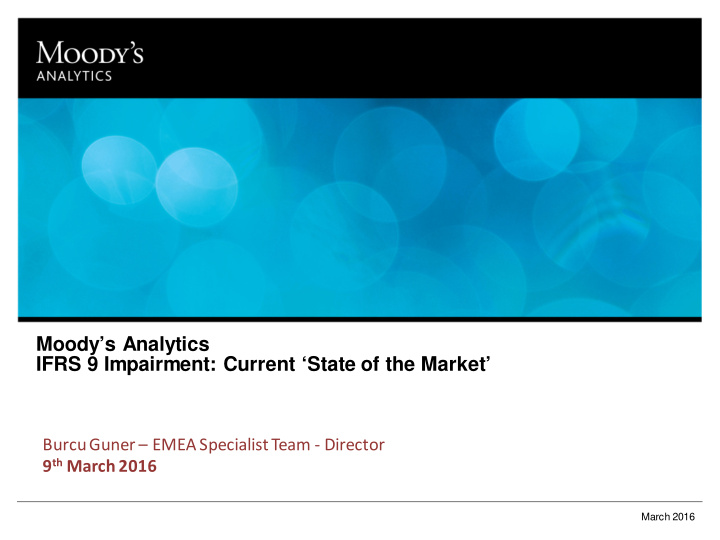



Moody’s Analytics IFRS 9 Impairment: Current ‘State of the Market’ Burcu Guner – EMEA Specialist Team - Director 9 th March 2016 March 2016
Forward looking IFRS 9 Impairment Calculation » Emphasis was on the estimation of forward-looking scenarios – neither to estimate a worst-case scenario nor to estimate the best-case scenario » Industry practice is to use multiple scenarios and calculate the probability weighted outcome of Expected Credit Losses (ECL) » ECL is the possibility that a credit loss occurs even if the most likely outcome is no credit loss – in contrast to the predecessor IAS 39 on incurred losses too late too little » The estimate of expected credit losses will need to reflect an unbiased and probability-weighted amount that is determined by evaluating a range of possible outcomes March 2016
Guidance around IFRS 9 Impairment Calculation Basel Guidance » Supervisory guidance is structured around 11 principles including: Governance & MI/BI reporting 1. senior management responsibilities and engagement 2. clearly documented and technically sound methodologies Common integrated 3. credit rating process to appropriately group lending exposures by credit risk characteristics transparent infrastructure & 4. adequacy of allow ance disclosures 5. validation of the models underlying the ECL calculation 6. use of experienced credit judgment 7. common data, systems and processes for both accounting and capital adequacy purposes Validation/Benchmarking & 8. transparency in public disclosures 9. periodic supervisory evaluation of each institution’s credit risk Expert Overlay practices 10. Supervisory assessment of the ECL measurement methodologies 11. Supervisory consideration of each institution’s credit risk practices w hen assessing capital adequacy Periodic Supervisory Evaluation March 2016
4 Current state at most banks in Europe » EBA 2016 IFRS 9 study to understand the estimated impact on: – r egulatory own funds – other prudential requirements, such as capital planning and stress testing requirements » Basel as well as supervisors will mostly release further guidelines and impact studies across the EU and beyond » Majority of financial institutions approach the challenge in three step: – “ Ongoing simulation tools ” for the impact studies – a number of banks indicated as such – “ Tactical ” solution for the actual Jan 2018 submissions – “ Strategic ” solution after the Jan 2018 submissions for Business As Usual March 2016
Macro Economic Scenarios CHALLENGE: Incorporate forward-looking scenarios into the measurement of Expected Credit Loss (ECL) INDUSTRY CONSIDERATIONS » Industry practice and supervisory guidelines to evolve » A number of approaches exist: » ECL is the weighted average of the ECLs calculated under multiple scenarios » Single scenario with an additional overlay to account for non-linearity » Used also for transferring criteria (stage transitions) » Internal versus External forecast sources » Bottom up versus portfolio/sub-portfolio level macro economic linkages » Regression based models for conditional PD, LGD, EAD based on macro economic scenarios March 2016
Transferring Criteria – Significant Deterioration of Credit Risk CHALLENGE: Assess each loan to determine whether there has been a significant increase in credit risk INDUSTRY CONSIDERATIONS » Incorporate both quantitative and qualitative assessments » Use of 12 month PD versus Lifetime PD (complexity) » Standard confirms that use of lifetime PD whilst there is allowance for the 12 month PD under certain conditions » Justification and ongoing monitoring when 12 month is adopted » Account for macroeconomic adjustments beyond the 12 month horizon » External/internal ratings are deemed less appropriate » Many banks are performing impact analysis in the choice of 12 month PD and Lifetime PD in transferring criteria March 2016
Expected Credit Loss Calculations – Process Governance CHALLENGE: Calculation Process Flow of ECL requires further insights and guidelines by industry and supervisors INDUSTRY CONSIDERATIONS Recent ITG discussion: Calculate the lifetime PD under each of the multiple scenarios • Combine the multiple lifetime PDs to get a probability weighted lifetime PD • Perform stage allocation based on lifetime PD • Calculate 12 month ECL if Stage 1 • Lifetime ECL for Stage 2 and 3 • Management/Expert Overlay: Short term scenario • Longer term quantitative assessment not possible • March 2016
Expected Credit Loss Calculations – Model Governance CHALLENGE: Calculating Lifetime ECL (PD, LGD, EAD) requires adjustments to existing models or the deployment of new models . INDUSTRY CONSIDERATIONS » Convert through-the-cycle PD/rating from Basel capital models to an IFRS 9 compliant Lifetime PD term structure. » Support scenario-based analysis for IFRS 9 impairment calculations and stage allocation logic. » Need for robust data tools to challenge and benchmark ECL estimates ( Challenger models and benchmark datasets) » Best Estimate and Point in Time Lifetime PD measures » Estimated with data consistent with other prudential requirements, such as capital planning and stress testing » Leveraging 12 month PD used for both Basel and IFRS9 Impairment purposes, ensuring consistency. » Historical default observations and vintage/portfolio segment analysis for PD extrapolation March 2016
Common integrated transparent infrastructure & disclosures CHALLENGE: Short implementation timeframe with challenges around performance and adoption of a new standard CREDIT IMPAIRMENT ANALYSIS SOFTWARE » Designed towards IFRS9 Variance analysis » A platform built on top of our Credit risk and regulatory expertise » Offering built in credit risk model management » Incorporating flexibility for PD/EAD/LGD calculation logic » A standard offering to meet regulatory deadlines » Standard data mapping and functionalities requiring little customization » A software platform offering services for compliance » Auditability/Tracability » Performance and scalability March 2016
Q&A Session Please use the chat function to ask questions After the webinar please send your questions to: stresstesting@moodys.com Next IFRS 9 Webinar: Moody’s Analytics Credit Loss and Impairment Analysis Suite (March 17 th at 9:30am) To Register, please email: stresstesting@moodys.com or visit www.moodysanalytics.com/News-Events/Events-Calendar All recordings and slides will be made available after the webinar session . March 2016
Upcoming Roadshow Moody’s Analytics IFRS 9 Forum Amsterdam, The Netherlands 15 th March 2016 Frankfurt a.M., Germany 27 th April 2016 Vienna, Austria 4 th May 2016 To Register, please email: stresstesting@moodys.com March 2016
Recommend
More recommend